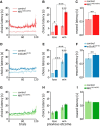Selective Effects of the Loss of NMDA or mGluR5 Receptors in the Reward System on Adaptive Decision-Making
- PMID: 30302389
- PMCID: PMC6175304
- DOI: 10.1523/ENEURO.0331-18.2018
Selective Effects of the Loss of NMDA or mGluR5 Receptors in the Reward System on Adaptive Decision-Making
Abstract
Selecting the most advantageous actions in a changing environment is a central feature of adaptive behavior. The midbrain dopamine (DA) neurons along with the major targets of their projections, including dopaminoceptive neurons in the frontal cortex and basal ganglia, play a key role in this process. Here, we investigate the consequences of a selective genetic disruption of NMDA receptor and metabotropic glutamate receptor 5 (mGluR5) in the DA system on adaptive choice behavior in mice. We tested the effects of the mutation on performance in the probabilistic reinforcement learning and probability-discounting tasks. In case of the probabilistic choice, both the loss of NMDA receptors in dopaminergic neurons or the loss mGluR5 receptors in D1 receptor-expressing dopaminoceptive neurons reduced the probability of selecting the more rewarded alternative and lowered the likelihood of returning to the previously rewarded alternative (win-stay). When observed behavior was fitted to reinforcement learning models, we found that these two mutations were associated with a reduced effect of the expected outcome on choice (i.e., more random choices). None of the mutations affected probability discounting, which indicates that all animals had a normal ability to assess probability. However, in both behavioral tasks animals with targeted loss of NMDA receptors in dopaminergic neurons or mGluR5 receptors in D1 neurons were significantly slower to perform choices. In conclusion, these results show that glutamate receptor-dependent signaling in the DA system is essential for the speed and accuracy of choices, but at the same time probably is not critical for correct estimation of probable outcomes.
Keywords: decision-making; dopamine; glutamate receptors; mouse behavior; reinforcement learning.
Figures







Similar articles
-
NMDA Receptors on Dopaminoceptive Neurons Are Essential for Drug-Induced Conditioned Place Preference.eNeuro. 2016 Jun 9;3(3):ENEURO.0084-15.2016. doi: 10.1523/ENEURO.0084-15.2016. eCollection 2016 May-Jun. eNeuro. 2016. PMID: 27294197 Free PMC article.
-
Novelty-seeking behaviors and the escalation of alcohol drinking after abstinence in mice are controlled by metabotropic glutamate receptor 5 on neurons expressing dopamine d1 receptors.Biol Psychiatry. 2013 Feb 1;73(3):263-70. doi: 10.1016/j.biopsych.2012.07.019. Epub 2012 Aug 16. Biol Psychiatry. 2013. PMID: 22902169
-
Conditional deletion of the AMPA-GluA1 and NMDA-GluN1 receptor subunit genes in midbrain D1 neurons does not alter cocaine reward in mice.Neuropharmacology. 2024 Nov 1;258:110081. doi: 10.1016/j.neuropharm.2024.110081. Epub 2024 Jul 15. Neuropharmacology. 2024. PMID: 39002853
-
Dopamine signaling in reward-related behaviors.Front Neural Circuits. 2013 Oct 11;7:152. doi: 10.3389/fncir.2013.00152. eCollection 2013. Front Neural Circuits. 2013. PMID: 24130517 Free PMC article. Review.
-
Serotoninergic and dopaminergic modulation of cortico-striatal circuit in executive and attention deficits induced by NMDA receptor hypofunction in the 5-choice serial reaction time task.Front Neural Circuits. 2014 Jun 11;8:58. doi: 10.3389/fncir.2014.00058. eCollection 2014. Front Neural Circuits. 2014. PMID: 24966814 Free PMC article. Review.
Cited by
-
Time elapsed between choices in a probabilistic task correlates with repeating the same decision.Eur J Neurosci. 2021 Apr;53(8):2639-2654. doi: 10.1111/ejn.15144. Epub 2021 Mar 2. Eur J Neurosci. 2021. PMID: 33559232 Free PMC article.
-
A Normative Account of Confirmation Bias During Reinforcement Learning.Neural Comput. 2022 Jan 14;34(2):307-337. doi: 10.1162/neco_a_01455. Neural Comput. 2022. PMID: 34758486 Free PMC article.
-
Lasting dynamic effects of the psychedelic 2,5-dimethoxy-4-iodoamphetamine ((±)-DOI) on cognitive flexibility.Mol Psychiatry. 2024 Jun;29(6):1810-1823. doi: 10.1038/s41380-024-02439-2. Epub 2024 Feb 7. Mol Psychiatry. 2024. PMID: 38321122 Free PMC article.
-
Group I metabotropic glutamate receptor antagonists impair discriminability of reinforcer magnitude, but not risky choice, in a probability-discounting task.Behav Brain Res. 2019 Jun 3;365:77-81. doi: 10.1016/j.bbr.2019.02.047. Epub 2019 Mar 1. Behav Brain Res. 2019. PMID: 30831139 Free PMC article.
-
Dopamine encoding of novelty facilitates efficient uncertainty-driven exploration.PLoS Comput Biol. 2024 Apr 16;20(4):e1011516. doi: 10.1371/journal.pcbi.1011516. eCollection 2024 Apr. PLoS Comput Biol. 2024. PMID: 38626219 Free PMC article.
References
Publication types
MeSH terms
Substances
Grants and funding
LinkOut - more resources
Full Text Sources
Molecular Biology Databases
Miscellaneous
